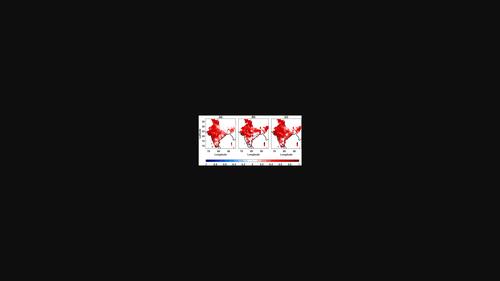当前位置:
X-MOL 学术
›
Int. J. Climatol.
›
论文详情
Our official English website, www.x-mol.net, welcomes your
feedback! (Note: you will need to create a separate account there.)
Assessment of hot weather seasonal temperatures over India using Monsoon Mission Coupled Forecasting System hindcasts
International Journal of Climatology ( IF 3.5 ) Pub Date : 2022-09-12 , DOI: 10.1002/joc.7866 P Rohini 1, 2 , M Rajeevan 3 , Suryachandra A Rao 2 , Prasanth A Pillai 2
International Journal of Climatology ( IF 3.5 ) Pub Date : 2022-09-12 , DOI: 10.1002/joc.7866 P Rohini 1, 2 , M Rajeevan 3 , Suryachandra A Rao 2 , Prasanth A Pillai 2
Affiliation

|
The present study evaluates the skill of seasonal forecasts of temperatures over India during April to June using the Monsoon Mission Coupled Forecasting System (MMCFS) model hindcasts, which are initialized with February initial conditions. Model hindcast data of 1981–2017 period have been used for the analysis. The India Meteorological Department (IMD) gridded temperature dataset has been used for model verifications. The MMCFS model captures the annual cycle of temperatures reasonably well, but with a higher mean and smaller variability compared to observations. The model hindcasts show a significant skill for seasonal forecasts of temperatures over most of northwest and central India. Empirical Orthogonal Function (EOF) analysis suggests that the model captures temporal and spatial characteristics of different modes of maximum temperatures but with less accuracy. The model teleconnections of maximum temperatures with Indian Ocean sea surface temperatures (SSTs) and El Niño–Southern Oscillation (ENSO) are weakly represented. The model is also found capable of predicting the spatial distribution of heat wave characteristics such as heat wave frequency (HWF) and heat wave duration (HWD) reasonably well. The present study suggests that the MMCFS Model can be used to generate a useful outlook of hot weather seasonal temperatures and heat waves over India.
中文翻译:

使用季风任务耦合预报系统后报评估印度的炎热季节温度
本研究使用季风任务耦合预报系统 (MMCFS) 模型后报评估了 4 月至 6 月期间印度气温的季节性预报技能,该模型以 2 月的初始条件进行了初始化。1981-2017 年期间的模型后报数据已用于分析。印度气象局 (IMD) 网格化温度数据集已用于模型验证。MMCFS 模型相当好地捕捉了温度的年度循环,但与观测相比具有更高的平均值和更小的变异性。模型后报显示了对印度西北部和中部大部分地区温度进行季节性预报的重要技巧。经验正交函数 (EOF) 分析表明,该模型捕获了最高温度不同模式的时间和空间特征,但准确性较低。最高温度与印度洋海面温度 (SST) 和厄尔尼诺-南方涛动 (ENSO) 的模型遥相关表现较弱。还发现该模型能够很好地预测热浪特征的空间分布,例如热浪频率(HWF)和热浪持续时间(HWD)。本研究表明,MMCFS 模型可用于生成印度炎热天气季节性温度和热浪的有用展望。最高温度与印度洋海面温度 (SST) 和厄尔尼诺-南方涛动 (ENSO) 的模型遥相关表现较弱。还发现该模型能够很好地预测热浪特征的空间分布,例如热浪频率(HWF)和热浪持续时间(HWD)。本研究表明,MMCFS 模型可用于生成印度炎热天气季节性温度和热浪的有用展望。最高温度与印度洋海面温度 (SST) 和厄尔尼诺-南方涛动 (ENSO) 的模型遥相关表现较弱。还发现该模型能够很好地预测热浪特征的空间分布,例如热浪频率(HWF)和热浪持续时间(HWD)。本研究表明,MMCFS 模型可用于生成印度炎热天气季节性温度和热浪的有用展望。
更新日期:2022-09-12
中文翻译:

使用季风任务耦合预报系统后报评估印度的炎热季节温度
本研究使用季风任务耦合预报系统 (MMCFS) 模型后报评估了 4 月至 6 月期间印度气温的季节性预报技能,该模型以 2 月的初始条件进行了初始化。1981-2017 年期间的模型后报数据已用于分析。印度气象局 (IMD) 网格化温度数据集已用于模型验证。MMCFS 模型相当好地捕捉了温度的年度循环,但与观测相比具有更高的平均值和更小的变异性。模型后报显示了对印度西北部和中部大部分地区温度进行季节性预报的重要技巧。经验正交函数 (EOF) 分析表明,该模型捕获了最高温度不同模式的时间和空间特征,但准确性较低。最高温度与印度洋海面温度 (SST) 和厄尔尼诺-南方涛动 (ENSO) 的模型遥相关表现较弱。还发现该模型能够很好地预测热浪特征的空间分布,例如热浪频率(HWF)和热浪持续时间(HWD)。本研究表明,MMCFS 模型可用于生成印度炎热天气季节性温度和热浪的有用展望。最高温度与印度洋海面温度 (SST) 和厄尔尼诺-南方涛动 (ENSO) 的模型遥相关表现较弱。还发现该模型能够很好地预测热浪特征的空间分布,例如热浪频率(HWF)和热浪持续时间(HWD)。本研究表明,MMCFS 模型可用于生成印度炎热天气季节性温度和热浪的有用展望。最高温度与印度洋海面温度 (SST) 和厄尔尼诺-南方涛动 (ENSO) 的模型遥相关表现较弱。还发现该模型能够很好地预测热浪特征的空间分布,例如热浪频率(HWF)和热浪持续时间(HWD)。本研究表明,MMCFS 模型可用于生成印度炎热天气季节性温度和热浪的有用展望。











































 京公网安备 11010802027423号
京公网安备 11010802027423号